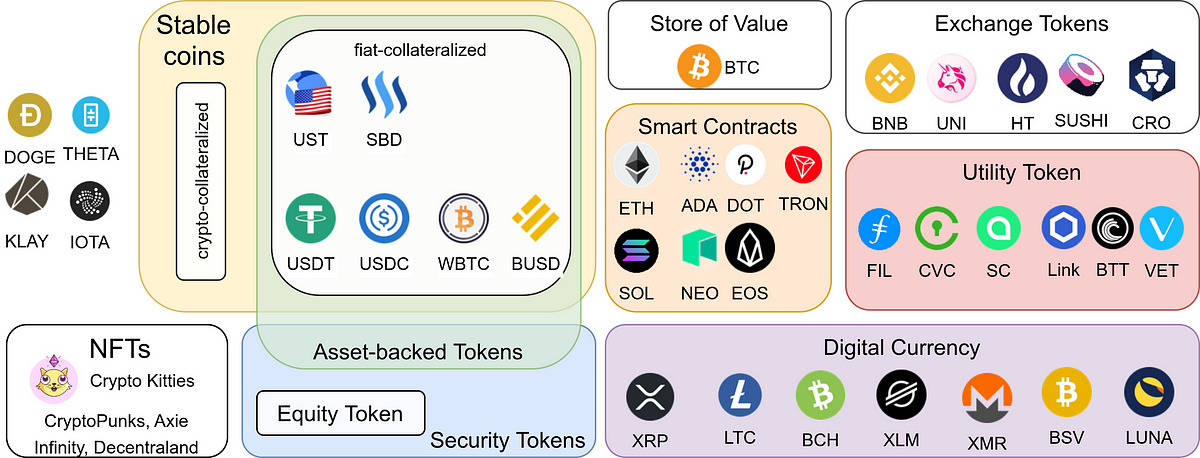Introduction
Welcome to the exciting world of cryptocurrencies! As digital assets that have gained immense popularity in recent years, cryptocurrencies have revolutionized the way we think about money and financial transactions. One key aspect that sets cryptocurrencies apart is their decentralized nature. But what exactly does that mean? In this article, we will explore the fundamental difference between centralized and decentralized cryptocurrencies.
At a basic level, centralized and decentralized cryptocurrencies differ in the way they are governed and operated. Centralized cryptocurrencies are controlled by a single entity or organization, while decentralized cryptocurrencies operate on a peer-to-peer network with no central authority. Understanding the distinctions between these two models is crucial to comprehend the potential benefits and drawbacks associated with each.
In the following sections, we will delve deeper into centralized and decentralized cryptocurrencies, exploring their characteristics, advantages, and disadvantages. We will then highlight the key differences between the two models, providing examples of notable cryptocurrencies for each category. By the end of this article, you will have a comprehensive understanding of the nuances between centralized and decentralized cryptocurrencies, allowing you to make informed decisions in the dynamic world of digital finance.
Definition of Centralized and Decentralized Cryptocurrency
Before diving into the specifics, let’s first define what we mean by centralized and decentralized cryptocurrencies.
Centralized cryptocurrency refers to a digital currency system that is controlled and managed by a central authority or organization. In this model, a central entity has complete control over the operation, development, and governance of the cryptocurrency. This authority can influence various aspects such as transaction validation, network rules, and policy decisions. Users typically need to trust this central authority to ensure the security and integrity of the cryptocurrency.
In contrast, decentralized cryptocurrency operates on a distributed network of computers, with no central governing authority. Transactions and operations are verified and executed by a network of participants, known as nodes. Each node maintains a copy of the ledger, ensuring transparency and consensus. This decentralized approach eliminates the need for a central entity, offering greater autonomy and security.
It’s important to note that decentralization can exist on a spectrum, and not all decentralized cryptocurrencies are equally decentralized. Some cryptocurrencies may have semi-centralized elements or dependencies on certain entities, while others strive for complete decentralization.
Now that we have a clear understanding of the basic definitions, let’s explore the characteristics, advantages, and disadvantages of centralized and decentralized cryptocurrencies in the next sections.
Centralized Cryptocurrency
Centralized cryptocurrencies, as the name suggests, operate under the control and oversight of a central authority or entity. This authority is responsible for managing and governing the cryptocurrency ecosystem. Let’s take a closer look at the characteristics, advantages, and disadvantages of centralized cryptocurrencies.
Characteristics of Centralized Cryptocurrency:
- Central Authority: Centralized cryptocurrencies have a designated central authority that governs and controls the operations of the cryptocurrency.
- Transaction Validation: Transactions are typically validated by the central authority or a select group of validators appointed by the authority.
- Network Rules: The central authority determines the rules and protocols that govern the cryptocurrency network.
- Policy Decisions: The central authority has the power to make policy decisions regarding the cryptocurrency, such as changing transaction fees or implementing upgrades.
Advantages of Centralized Cryptocurrency:
- Efficiency: Centralized cryptocurrencies can often process transactions more quickly and efficiently due to their centralized infrastructure.
- Accountability: As a centralized authority is responsible for the cryptocurrency, they can be held accountable for security breaches and fraudulent activities.
- Regulation Possibilities: Centralized cryptocurrencies may have more regulatory compliance possibilities, which can provide a sense of stability and legitimacy for users.
Disadvantages of Centralized Cryptocurrency:
- Single Point of Failure: As the entire cryptocurrency ecosystem is dependent on the central authority, any failure or compromise of the authority can have severe consequences for the network.
- Lack of Privacy: Centralized cryptocurrencies often require users to disclose personal information, compromising privacy.
- Limited Transparency: The decision-making process and governance of centralized cryptocurrencies may lack transparency, leading to potential issues of trust.
While centralized cryptocurrencies offer benefits such as efficiency and accountability, they also come with inherent risks and limitations. Now that we have explored centralized cryptocurrencies, let’s move on to understanding decentralized cryptocurrencies in the next section.
Characteristics of Centralized Cryptocurrency
Centralized cryptocurrencies possess distinct characteristics that distinguish them from their decentralized counterparts. Understanding these characteristics is essential for comprehending the dynamics and operational aspects of centralized cryptocurrencies. Let’s explore the key characteristics of centralized cryptocurrencies.
1. Central Authority: Centralized cryptocurrencies are governed by a central authority, typically an organization or entity, that exercises control over the entire cryptocurrency ecosystem. This central authority holds the power to make decisions regarding operations, changes in rules, and policy implementations.
2. Transaction Validation: In centralized cryptocurrency networks, the validation of transactions is undertaken by the central authority or a group of validators appointed by the authority. These validators ensure the accuracy and integrity of transactions’ information before they are added to the cryptocurrency’s ledger.
3. Network Rules: The central authority defines and enforces the rules, protocols, and procedures that govern the operations of the centralized cryptocurrency network. These rules include factors such as transaction fees, block confirmation times, and consensus mechanisms.
4. Policy Decisions: The central authority has the sole discretion to make policy decisions that impact the centralized cryptocurrency ecosystem. This authority can introduce upgrades, implement changes to transaction processing, or modify network rules based on their assessment of the cryptocurrency’s needs.
5. Centralized Infrastructure: Centralized cryptocurrencies rely on a centralized infrastructure maintained and operated by the central authority. This infrastructure is responsible for the storage of user data, transaction processing, and the overall functioning of the cryptocurrency network.
6. Access Control: Access to centralized cryptocurrencies is typically controlled by the central authority. The authority may require user registration, verification of identity, and compliance with Know Your Customer (KYC) and Anti-Money Laundering (AML) regulations to access and transact with the cryptocurrency.
These defining characteristics demonstrate the centralized nature of these cryptocurrencies. While they offer certain advantages such as efficiency and accountability, they also raise concerns regarding single points of failure, lack of privacy, and limited transparency. It is important to consider these characteristics when evaluating centralized cryptocurrencies and their suitability for various use cases.
Advantages of Centralized Cryptocurrency
Centralized cryptocurrencies, despite their inherent limitations, offer several advantages that can be appealing to users and organizations. These advantages contribute to the popularity and widespread adoption of centralized cryptocurrencies. Let’s explore some of the key advantages of centralized cryptocurrency.
1. Efficiency: Centralized cryptocurrency networks are often more efficient in terms of transaction processing and scalability. With a centralized infrastructure and a designated authority overseeing operations, transactions can be processed quickly, allowing for smoother user experiences and improved transaction throughput.
2. Accountability: As centralized cryptocurrencies operate under the oversight of a central authority, this authority can be held accountable for any security breaches or fraudulent activities that may occur. Users can rely on the authority to take necessary measures to address such issues, ensuring a level of accountability that may be lacking in decentralized systems.
3. Regulatory Compliance: Centralized cryptocurrencies have the potential for easier regulatory compliance. As the central authority exercises control over the network, they can enforce regulatory requirements such as KYC (Know Your Customer) and AML (Anti-Money Laundering) procedures. This compliance can provide users with an added sense of security and legitimacy in their transactions.
4. Stability: Centralized cryptocurrencies tend to offer greater stability and predictability. The centralized authority can implement measures to mitigate market volatility, control supply and demand, and quickly address any anomalies or issues that may arise. This stability can be particularly beneficial for users who value a steady and predictable cryptocurrency environment.
5. Technical Support: The presence of a central authority in centralized cryptocurrencies allows for dedicated technical support and customer service. Users can seek assistance and resolve any issues they encounter through direct contact with the authority. This support can help address user concerns promptly, enhancing the overall user experience.
These advantages make centralized cryptocurrency systems attractive for certain use cases where efficient transactions, accountability, regulatory compliance, stability, and reliable support are critical. However, it is important to consider the drawbacks and limitations associated with centralization to make an informed decision when choosing a cryptocurrency model.
Disadvantages of Centralized Cryptocurrency
While centralized cryptocurrencies offer certain advantages, they also come with inherent disadvantages that users and organizations should be aware of. These drawbacks highlight some of the limitations and risks associated with centralized cryptocurrency systems. Let’s explore the key disadvantages of centralized cryptocurrency.
1. Single Point of Failure: Centralized cryptocurrencies are susceptible to a single point of failure. If the central authority experiences technical issues, security breaches, or becomes compromised in any way, the entire network and its users are affected. This vulnerability can lead to disruptions in transaction processing and potential loss of funds for users.
2. Lack of Privacy: Centralized cryptocurrency systems often require users to disclose personal information and adhere to KYC and AML regulations. This requirement compromises user privacy, as the authority has access to user data and transaction history. The centralized nature of the network increases the risk of data breaches and unauthorized access to sensitive information.
3. Limited Transparency: The decision-making process and governance of centralized cryptocurrencies may lack transparency. Users may not have full visibility into the policies, rule changes, and decision criteria employed by the central authority. This limited transparency can lead to concerns about potential biases, favoritism, or manipulation within the ecosystem.
4. Dependency on Central Authority: In centralized cryptocurrency systems, users are heavily reliant on the central authority. Their trust in the authority’s competence, integrity, and commitment to security is crucial for the safety and reliability of the cryptocurrency. If users lose confidence in the authority, it can have significant implications for the network’s credibility and user adoption.
5. Potential for Regulatory Intervention: Centralized cryptocurrencies, due to their centralized nature and potential for regulatory compliance, are more susceptible to regulatory intervention. Government regulations and policies can impact the operation, accessibility, and even the existence of centralized cryptocurrencies, posing risks to users’ assets and overall stability.
These disadvantages highlight some of the challenges and concerns associated with centralized cryptocurrency systems. It is important for users to carefully evaluate these drawbacks and consider their own priorities and risk tolerance when deciding whether to engage with centralized cryptocurrency platforms.
Decentralized Cryptocurrency
Decentralized cryptocurrencies operate on a peer-to-peer network, eliminating the need for a central authority or intermediary. This decentralized model offers a range of unique characteristics and benefits that set it apart from centralized cryptocurrency systems. Let’s take a closer look at decentralized cryptocurrencies and explore their key aspects.
Characteristics of Decentralized Cryptocurrency:
- Peer-to-Peer Network: Decentralized cryptocurrencies operate on a network of interconnected computers, known as nodes. Transactions are validated and recorded by these nodes, ensuring transparency and consensus.
- Distributed Ledger: Rather than relying on a central authority to maintain a ledger, decentralized cryptocurrencies utilize a distributed ledger, also known as a blockchain. This ledger is replicated and synchronized across multiple nodes, ensuring that no single entity has control over the entire dataset.
- Consensus Mechanisms: Decentralized cryptocurrencies employ various consensus mechanisms, such as Proof of Work (PoW) or Proof of Stake (PoS), to validate transactions and maintain network integrity. These mechanisms enable participants to collectively agree on the state of the blockchain.
- Autonomy: In a decentralized cryptocurrency system, users have greater autonomy and control over their funds and transactions. There is no central authority to impose restrictions or impose fees, giving users more freedom to engage in peer-to-peer transactions.
Advantages of Decentralized Cryptocurrency:
- Security: Decentralized cryptocurrencies are inherently more resistant to attacks and censorship. With no single point of control, it is difficult for malicious actors to manipulate or compromise the network.
- Transparency: The use of a distributed ledger ensures transparency in decentralized cryptocurrencies. All transactions are recorded in the blockchain, allowing for public verification and scrutiny.
- Privacy: Decentralized cryptocurrencies often prioritize privacy by design. Users can execute transactions and engage in financial activities without having to disclose their personal information.
Disadvantages of Decentralized Cryptocurrency:
- Scalability: Some decentralized cryptocurrencies face challenges in scaling to accommodate a large number of transactions. The consensus mechanisms and distributed nature of the network can limit transaction throughput.
- Technical Complexity: Participating in decentralized cryptocurrency systems may require users to have a certain level of technical knowledge and familiarity with digital wallets, private keys, and blockchain technology.
Decentralized cryptocurrencies offer a range of advantages such as increased security, transparency, and privacy. However, they also face challenges related to scalability and technical complexity. Understanding these characteristics and considering them in the context of your specific needs and preferences can help determine whether decentralized cryptocurrencies are the right choice for you.
Characteristics of Decentralized Cryptocurrency
Decentralized cryptocurrencies possess unique characteristics that differentiate them from centralized counterparts. These characteristics define the nature and functioning of decentralized cryptocurrencies, offering distinct advantages to users. Let’s explore the key characteristics of decentralized cryptocurrency.
1. Peer-to-Peer Network: Decentralized cryptocurrencies operate on a peer-to-peer network, where participants interact directly with each other without the need for intermediaries or central authorities. Transactions are verified by multiple nodes, ensuring transparency and consensus.
2. Distributed Ledger: Decentralized cryptocurrencies utilize a distributed ledger, commonly known as a blockchain. This ledger is replicated and stored across multiple nodes in the network. Each participant maintains a copy of this ledger, ensuring that no single entity has control over the entire dataset.
3. Consensus Mechanisms: Decentralized cryptocurrencies employ consensus mechanisms to validate and secure transactions. These mechanisms, such as Proof of Work (PoW) or Proof of Stake (PoS), ensure that participants collectively agree on the state of the blockchain, preventing malicious activities and maintaining network integrity.
4. Autonomy: Decentralized cryptocurrency systems offer greater autonomy and control to users. Unlike centralized systems, there is no central authority that can impose restrictions, enforce fees, or freeze accounts. Users have the freedom to engage in peer-to-peer transactions without intermediaries.
5. Transparency: Decentralized cryptocurrencies prioritize transparency through the use of a public blockchain. All transactions are recorded on the blockchain and can be verified by anyone, ensuring transparency and accountability in the network.
6. Privacy: Privacy is often a significant aspect of decentralized cryptocurrencies. Users can transact and engage in financial activities without the need to disclose personal information. Pseudonymous addresses and cryptographic techniques allow for privacy-enhanced transactions.
These characteristics define the core functioning of decentralized cryptocurrencies. Their peer-to-peer nature, distributed ledger, consensus mechanisms, autonomy, transparency, and privacy provide a range of benefits for users seeking increased security and control over their financial transactions. However, it is important to consider the challenges related to scalability and technical complexity that may arise in decentralized systems.
Advantages of Decentralized Cryptocurrency
Decentralized cryptocurrencies offer a myriad of advantages that have contributed to their growing popularity and adoption. These advantages stem from their unique characteristics and decentralized nature. Let’s explore some of the key advantages of decentralized cryptocurrency.
1. Security: Decentralized cryptocurrency systems provide enhanced security compared to their centralized counterparts. The distributed ledger and consensus mechanisms make it challenging for malicious actors to manipulate or attack the network. Decentralization reduces the risk of a single point of failure, making decentralized cryptocurrencies more resilient to hacking attempts or system failures.
2. Transparency: Decentralized cryptocurrencies prioritize transparency through the use of a public blockchain. All transactions recorded on the blockchain can be viewed and verified by anyone. This transparency fosters trust and accountability in the network, as users can independently validate the integrity of transactions without relying on a central authority.
3. Privacy: Many decentralized cryptocurrencies emphasize privacy as a core feature. Through cryptographic techniques and pseudonymous addresses, users can engage in transactions without revealing their personal information. This privacy-centric approach empowers individuals to maintain their financial autonomy and confidentiality.
4. Financial Inclusion: Decentralized cryptocurrencies promote financial inclusion by providing access to financial services for individuals who are unable to access traditional banking systems. With no need for intermediaries or a central authority, anyone with an internet connection can participate in decentralized cryptocurrency networks, opening up opportunities for individuals who are unbanked or underbanked.
5. Resistance to Censorship: Decentralized cryptocurrencies are resistant to censorship as there is no central authority that can impose restrictions on transactions or freeze accounts. This attribute is particularly relevant in regions where governments or financial institutions may apply strict controls over traditional financial systems. Decentralized cryptocurrencies provide individuals with financial sovereignty and the ability to conduct transactions freely.
6. Innovation and Community Involvement: Decentralized cryptocurrency systems foster innovation by allowing anyone to participate in the network and contribute to its development. The open nature of decentralized cryptocurrencies encourages collaboration and community involvement, leading to the creation of new applications, protocols, and services that can benefit the entire ecosystem.
These advantages make decentralized cryptocurrencies attractive for users seeking increased security, transparency, privacy, financial inclusivity, and resistance to censorship. However, it is important to consider factors such as scalability, technical complexity, and regulatory challenges when evaluating the feasibility of decentralized cryptocurrencies for specific use cases or investment decisions.
Disadvantages of Decentralized Cryptocurrency
While decentralized cryptocurrencies offer a range of advantages, they also come with certain disadvantages that users and organizations should take into consideration. These drawbacks highlight some of the challenges and limitations associated with decentralized cryptocurrency systems. Let’s explore the key disadvantages of decentralized cryptocurrency.
1. Scalability: One of the primary challenges faced by decentralized cryptocurrencies is scalability. As the number of transactions increases, the consensus mechanisms and distributed nature of the network can lead to slower transaction processing times and increased fees. Scaling solutions such as off-chain transactions or layer-two solutions are being explored, but their implementation and adoption are still ongoing.
2. Technical Complexity: Participating in decentralized cryptocurrency systems often requires users to have a certain level of technical knowledge. Understanding concepts such as digital wallets, private keys, and blockchain technology can be daunting for newcomers. This technical complexity may hinder the widespread adoption of decentralized cryptocurrencies among the mainstream population.
3. Regulatory Challenges: Decentralized cryptocurrencies, by their nature, may face regulatory challenges and uncertainties. Some jurisdictions may impose restrictions, require compliance with stringent regulations, or even prohibit the usage and trading of decentralized cryptocurrencies. These regulatory challenges can impact the accessibility and acceptance of decentralized cryptocurrencies on a global scale.
4. Energy Consumption: Certain decentralized cryptocurrencies, such as those utilizing Proof of Work (PoW) consensus mechanisms, are known for their high energy consumption. The computational power required for mining and securing the network can result in significant energy consumption, raising concerns about environmental sustainability.
5. Irreversibility of Transactions: Transactions conducted on decentralized cryptocurrency networks are typically irreversible once confirmed and added to the blockchain. While this immutability is often seen as an advantage, it can also be a disadvantage in scenarios where errors or fraudulent transactions occur. Unlike centralized systems, there is no central authority to reverse or mediate such transactions.
6. Lack of Customer Support: Decentralized cryptocurrencies operate without a central authority responsible for customer support. If users encounter issues, such as the loss of private keys or technical difficulties, resolving these problems may prove challenging. The absence of a central support system may result in potential loss of funds or limited avenues for assistance.
It is important to carefully consider these disadvantages when engaging with decentralized cryptocurrency systems. While decentralized cryptocurrencies offer increased security, transparency, privacy, and financial autonomy, they also present technical and regulatory challenges that may impact their suitability for certain use cases or individuals.
Key Differences between Centralized and Decentralized Cryptocurrency
Centralized and decentralized cryptocurrencies diverge significantly in their structure, governance, and operation. Understanding the key differences between these two models is crucial for users seeking to navigate the world of digital finance effectively. Let’s explore the prominent distinctions between centralized and decentralized cryptocurrency.
1. Governance: The primary difference lies in the governance structure. Centralized cryptocurrencies are governed and controlled by a central authority or organization that dictates the rules, policies, and operations of the network. In contrast, decentralized cryptocurrencies operate on a peer-to-peer network, relying on a distributed consensus mechanism for decision-making. There is no central authority in decentralized systems, and participants collectively have a say in the network’s governance.
2. Control and Authority: Centralized cryptocurrencies centralize control and authority in a single entity or organization. This central authority possesses the power to make unilateral decisions, such as modifying rules, changing transaction fees, or implementing upgrades. Decentralized cryptocurrencies, on the other hand, distribute control among network participants, with no single entity wielding absolute control. Decision-making relies on consensus mechanisms, ensuring a more democratic and decentralized governance process.
3. Trust and Security: Trust is established differently in centralized and decentralized cryptocurrencies. Centralized cryptocurrencies rely on trust in the central authority to ensure security and integrity. Users place their trust in this authority to protect their funds and data. In contrast, decentralized cryptocurrencies rely on cryptographic algorithms, consensus mechanisms, and distributed ledger technology to achieve trust and security. The transparency and immutability of the blockchain provide a high level of security assurance.
4. Privacy: Privacy considerations differ in centralized and decentralized cryptocurrencies. Centralized cryptocurrencies often require users to disclose personal information and adhere to regulatory requirements, compromising privacy. Decentralized cryptocurrencies prioritize privacy by design, allowing users to transact pseudonymously without the need for disclosing personal information.
5. Scalability: Scalability is often a challenge for decentralized cryptocurrencies. The need for consensus among distributed nodes and the replication of the ledger across the network can hinder transaction processing speed and scalability. Centralized cryptocurrencies, on the other hand, can often process transactions more efficiently due to their centralized infrastructure.
6. Central Point of Failure: Centralized cryptocurrencies are susceptible to a single point of failure. If the central authority experiences technical issues, security breaches, or becomes compromised, the entire network could be at risk. However, decentralized cryptocurrencies distribute the ledger and decision-making across multiple nodes, eliminating the risk of a single point of failure.
These key differences highlight the contrasting features of centralized and decentralized cryptocurrencies. Centralized systems provide a centralized governance structure, while decentralized systems offer distributed control and democratized decision-making. Privacy, scalability, and the presence of a single point of failure are also pivotal distinctions. By understanding these differences, users can make informed decisions about which type of cryptocurrency aligns more closely with their preferences and requirements.
Examples of Centralized Cryptocurrency
Centralized cryptocurrencies have gained widespread recognition and adoption, with several notable examples dominating the market. These cryptocurrencies operate on a centralized model, governed by a central authority or organization. Let’s explore a few prominent examples of centralized cryptocurrencies:
1. Ripple (XRP): Ripple is a centralized cryptocurrency that aims to facilitate fast, low-cost international money transfers. The Ripple network operates through a series of trusted validators chosen by Ripple Labs. Transactions are validated by a select group of servers operated by these validators, giving Ripple control over the network and its future development.
2. Tether (USDT): Tether is a centralized cryptocurrency designed to maintain a stable value by pegging it to leading fiat currencies like the US dollar. Each Tether coin represents one unit of the corresponding fiat currency held in reserve. The management of Tether’s reserves and issuance is controlled by a centralized entity, which ensures the stability and value of the cryptocurrency.
3. Binance Coin (BNB): Binance Coin is the native cryptocurrency of the Binance exchange, one of the largest centralized cryptocurrency exchanges globally. BNB operates on the Binance Chain, a centralized blockchain governed by the Binance organization. BNB offers various utility functions on the Binance platform, including reduced trading fees and participation in token sales.
4. USD Coin (USDC): USD Coin is a centralized cryptocurrency that serves as a stablecoin, with its value pegged to the US dollar on a 1:1 basis. It is issued by a consortium known as Centre, which is managed by Circle and Coinbase. The centralized nature of USDC ensures regulatory compliance and provides stability in its value.
5. Libra (Diem): Libra, now rebranded as Diem, is a proposed cryptocurrency project by Facebook. While it was initially planned as a centralized cryptocurrency, the project has faced regulatory scrutiny and has evolved to embrace a more regulated and collaborative approach. The Diem association, a consortium of organizations, would govern and control the project.
These examples demonstrate the diverse applications and functionalities of centralized cryptocurrencies. While they offer certain advantages such as efficiency and stability, it is important to consider the centralization aspect and its implications on factors like privacy, security, and trust when engaging with these cryptocurrencies.
Examples of Decentralized Cryptocurrency
Decentralized cryptocurrencies have gained significant attention and adoption, offering users increased security, privacy, and control over their financial transactions. These cryptocurrencies operate on a peer-to-peer network with no central authority governing their operations. Let’s explore some notable examples of decentralized cryptocurrencies:
1. Bitcoin (BTC): Bitcoin is the first and most well-known decentralized cryptocurrency, introduced in 2009 by an anonymous individual or group known as Satoshi Nakamoto. Bitcoin operates on a public blockchain and utilizes the Proof of Work (PoW) consensus mechanism. It allows users to make secure, peer-to-peer transactions without the need for intermediaries.
2. Ethereum (ETH): Ethereum is a decentralized blockchain platform that introduced smart contracts, enabling the development and execution of decentralized applications (dApps). The Ethereum network has its native cryptocurrency called Ether (ETH). Ethereum’s decentralized nature allows for the creation of various decentralized applications, tokenization, and the implementation of decentralized finance (DeFi) protocols.
3. Cardano (ADA): Cardano is a decentralized cryptocurrency platform that aims to provide a secure and sustainable platform for the development of decentralized applications and smart contracts. It leverages a peer-reviewed research approach to ensure high-quality code and focuses on scalability, interoperability, and sustainability. Cardano’s ADA token is used for transactions and staking.
4. Monero (XMR): Monero is a privacy-focused decentralized cryptocurrency that prioritizes anonymity and untraceability. It employs various cryptographic techniques to obfuscate transaction details and hide user identities. Monero’s decentralized nature, combined with its privacy features, makes it appealing to users seeking enhanced financial confidentiality.
5. Stellar (XLM): Stellar is a decentralized blockchain platform designed for fast, low-cost cross-border transactions. It facilitates the issuance and transfer of various digital assets, including its native cryptocurrency, Lumens (XLM). Stellar’s decentralized network allows for the seamless transfer of assets and enables financial inclusion for underserved populations.
6. Tezos (XTZ): Tezos is a decentralized blockchain platform that emphasizes on-chain governance and formal verification. It enables the creation of smart contracts and decentralized applications, encouraging community-driven decision-making and protocol upgrades. Tezos uses a proof-of-stake (PoS) consensus mechanism and its native cryptocurrency is called Tez or Tezzies (XTZ).
These examples highlight the diversity of decentralized cryptocurrencies and their capabilities. Each decentralized cryptocurrency caters to different use cases and offers unique features, while operating on the foundational principles of decentralized governance, peer-to-peer transactions, and cryptographic security.
Conclusion
In the dynamic world of cryptocurrencies, understanding the difference between centralized and decentralized systems is essential for users and investors alike. Centralized cryptocurrencies rely on a central authority to govern and control their operations, offering efficiency, accountability, and regulatory compliance. However, they come with limitations such as single points of failure, lack of privacy, and dependence on a central authority.
On the other hand, decentralized cryptocurrencies operate on a peer-to-peer network, providing enhanced security, transparency, and privacy. They empower users with financial autonomy, resistance to censorship, and the potential for innovation. However, decentralized systems often face challenges related to scalability, technical complexity, and regulatory uncertainties.
It’s important to note that both centralized and decentralized cryptocurrencies have their own advantages and disadvantages, catering to different user preferences and use cases. The choice between the two depends on factors such as security needs, privacy concerns, regulatory compliance, and individual risk tolerance.
As the cryptocurrency landscape continues to evolve, it is likely that we will witness the emergence of new models and hybrid approaches that combine elements of centralization and decentralization. It’s crucial for users to stay informed and adapt to the changing dynamics of the cryptocurrency industry, while considering their own values, priorities, and risk management strategies.
By understanding the nuances between centralized and decentralized cryptocurrencies, individuals can navigate the cryptosphere with greater confidence and make informed decisions that align with their financial goals and preferences.

























